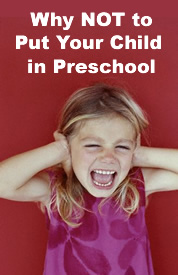NOTE: I wrote this article for Home School Enrichment Magazine, and it appeared in issue #39, May/June 2009. They have graciously allowed me to reprint it on my blog.
We’ve all seen them: products that promise to optimize your baby’s brain growth, increase the neural connections (synapses) in your baby’s brain, and give your baby a head start on learning. These claims are based on the fact that babies’ brains grow at a phenomenal rate, which, manufacturers claim, offers a unique “window of opportunity” that parents can use to maximize their baby’s development. Some manufacturers imply that if you miss this special window of opportunity, your baby’s intelligence will suffer. These claims are based on the premise that parents can somehow design or wire their baby’s brain, “building” a better baby. Better than they were before! Better, stronger, faster, and of course, smarter.
Many parents do believe that they can greatly influence their baby’s development. They believe that with the proper enrichment and stimulation, they can grow their baby into some sort of genius. Just follow the money and you’ll see the proof of these beliefs: parents spend more than 2 billion dollars on products promising such results every year. But do these products really work? To answer that question, we need to learn a little about brain development.
See How They Grow: Baby Brain Development
There is a lot about the human brain that scientists don’t know and can’t explain. Here are some things they do know: Babies are born with immature brains. While they contain almost the same amount of cells that adult brains do, the cells are not organized or connected properly (compared to an adult brain). During a baby’s first three years especially, his brain is busy building connections between cells. These connections are called neural connections, or synapses. By the time a child reaches three years old, his brain has made most of the necessary connections. In fact, your baby’s brain has made too many connections: the brain of a 3-year-old is twice as active as an adult’s brain. This is because his brain is less efficient than an adult’s brain. Over the next few years, the neural connections are refined: the connections that are used are strengthened, and those that are not needed are pruned away. But this pruning isn’t a bad thing. A child’s brain must prune connections in order to become more efficient. This is not the end of the story, though. The brain continues to grow and prune connections throughout life. Yes, you read that right: the truth is, the brain continues to grow and prune synapses as needed throughout life! Since babies build these synapses based on experience, many parents assume that the more experiences they can provide for their babies, the more connections their babies’ brains will make, the bigger their brains will be, and the smarter their babies will become. This is not necessarily true. A bigger brain is not a guarantee of greater intelligence. Just look at nature. Many animals have bigger brains than humans do; human males have larger brains than females. Size does not correlate to intelligence. What makes the human brain more intelligent is its unique, God-given organization and refinements.
Since the human brain grows at such a phenomenal rate during its first three years, many “experts” urge parents not to miss the special window of opportunity to influence baby’s mental development during those years. They warn that once missed, the opportunity will be lost forever. They claim that certain skills are especially important to introduce early—primarily the development of second languages and learning music. In truth, the optimal “window of development” extends much longer than some “experts” suppose. From the book, Einstein Never Used Flash Cards: “The window extends far beyond early childhood. Professor Huttenlocher writes, ‘Second-language teaching and musical training are likely to be more effective if started early, during the period of high plasticity, which includes the early school years (ages 5 to 10 years.)’ Thus, we needn’t rush music and language learning training into he crib.” [Emphasis added.]
There is great comfort in this—comfort for parents who have adopted an older child, for parents of developmentally delayed children, and for those of us who have older children. We should never think that it is too late to learn music or a second language. It is never too late to enrich and develop your child’s mind and abilities—or even your own.
The Truth about Early Learning Systems
There is no evidence that videos, flash cards, or other infant “learning systems” will make your child smarter. But there is considerable evidence to show they are harmful. As David Elkind says in Miseducation: Preschoolers at Risk, “When we instruct children in academic subjects, or in swimming, or gymnastics, or ballet, at too early an age, we miseducate them; we put them at risk for short term stress and long term personality damage for no useful purpose. There is no evidence that such early instruction has lasting benefits and considerable evidence that it can do lasting harm.” In Einstein Never Used Flashcards, the premise is put forth that the danger of too much early enrichment contributes to “neurological crowding.” This occurs when too much information is presented to children, competing with the neural connections that should be forming in the brain. This competition can potentially crowd out necessary connections and actually decrease the size and number of brain regions related to creativity and intelligence.
Babies need face-to-face interaction with responsive adults to learn. If you are truly concerned about helping your baby grow and develop his brain to its maximum capacity, you should spend time talking to and playing with your baby. Television takes away from a baby’s true learning time. In her article “Baby Einsteins: Not So Smart After All,” (TIME Magazine, August 6, 2007), Alice Park reports on a study from the University of Washington that showed that “With every hour per day spent watching baby DVDs and videos, infants learned six to eight fewer new vocabulary words than babies who never watched the videos. These products had the strongest detrimental effect on babies 8 to 16 months old, the age at which language skills are starting to form. The article continues: “Three studies have shown that watching television, even if it includes educational programming such as Sesame Street, delays language development. ‘Babies require face-to-face interaction to learn,’ says Dr. Vic Strasburger, professor of pediatrics at the University of New Mexico School of Medicine and a spokesperson for the American Academy of Pediatrics. ‘They don’t get that interaction from watching TV or videos. In fact, the watching probably interferes with the crucial wiring being laid down in their brains during early development.’”
Television and videos can actually delay language development instead of improving it. Additionally, some experts contend that television and videos actually shorten children’s attention spans, overstimulating their immature brains. Television trains children’s minds to expect high levels of stimulation—bright colors and quick changes. Real life is not always as interesting.
The AmericanAcademy of Pediatrics suggests that babies 2 and under shouldn’t watch any television and that it should be strictly limited even after this age. Television takes time away from play, exploration, and interaction with adults. This is where true learning takes place.
Finally, there’s context: Meaningful learning takes place in context. You can teach a baby to memorize the look and shape of words, and perhaps to recognize them, but without the appropriate life experiences and vocabulary to go with those reading skills, this “learning” is meaningless. They will not understand what they “read.” Research has proved over and over that there is no academic advantage to early reading.
What Parents Can Do to Enrich Baby’s Development
• Relationships first: developing a strong, emotional bond of love and trust is most important for you and your baby.
• During the early years, you are training your child’s habits and tastes. Television watching is a habit that is easy to acquire, but hard to break.
• Go ahead and expose your child to classical music. Sing to your children, too. This may not make them grow synapses, but it will help set their tastes. It will set the stage for appreciation of music, and later, learning music.
• Instead of television, provide your little ones with interesting things to see, do, and explore. Put your baby on a blanket on the floor and place colorful toys around him. Let your toddler play with play dough or explore an indoor “sandbox” made from oatmeal or rice (for toddlers who won’t put it in their mouths!) Add plastic measuring cups and plastic-ware for more fun.
• Change your baby’s point of view. Switch your baby between the floor, a swing, a bouncer seat, a playpen, your arms, etc., and give him a new perspective on the world.
• Talk to your baby/preschooler all the time, about everything you are doing. Talk to your baby using “parentese”: that special, high-pitched voice and exaggerated facial expressions parents instinctively use when talking to babies. Involve your baby in “conversations”: when baby makes a sound, copy it, and then talk to baby. Be sure to pause and give baby time to respond to what you say. This teaches conversation skills.
• Remember that the “experts” who misinterpret brain research to mean that babies must be sufficiently “stimulated” or “taught” before age 3 do so to promote their products. They are using fear and guilt to compel parents to buy unnecessary merchandise.
• This isn’t to say that babies don’t benefit from enriching activities. It is the type and amount of stimulation that matters. Natural learning, as always, prevails as the best way to stimulate your baby’s development: things like gentle, consistent care, talking to babies, singing to babies, and reading to babies.
• Gentle sensory stimulation, if not overused, can be beneficial to babies. Place small babies on different types of textures: carpet, blanket, parachutes, and so on. Play baby games like “X Marks the Spot” or “So Big.” Give your baby a gentle massage.
• If you want to spend some money on baby-learning products, remember that babies earn through relationship, interaction, play, and exploration. It would be better to invest in quality, old-fashioned toys and spend time playing with your baby than it would be to plop her down in front of a video.
Remember that there is no single window of opportunity that slams shut once babies reach a certain age. The brain continues to grow and prune synapses throughout life. You will not harm your baby by giving him a normal, loving babyhood minus the flash cards and videos. To the contrary—you will be giving your baby the best start possible.
© 2009 Homeschool Enrichment Magazine, all rights reserved. Used with permission.
You might also like: Curriculum for Babies?!
What Babies Really Need: Creating a Stimulating Home Environment
Reading Aloud to Babies and Toddlers










































